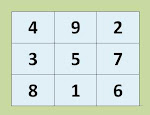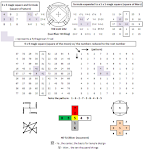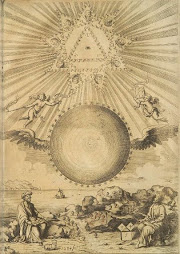The most
important magic square of all is the 27x27 magic square. This is the
magic square that the early Chinese came to realize was indeed magical and
relevant to the evolution and prosperity of humankind.
The 27x27
magic square was also significant to Plato and Pythagoras and is referenced in
Plato's Republic (Book IX):
The king lives sevenhundred-twentynine times more pleasantly than the
tyrant....
This passage referencing the number 729 is the key
to understanding the puzzle to Plato’s famous quote. However, it is instructive to understand some
background philosophy about Plato, Pythagoras, and the early Chinese before
illuminating on the impact the magic square had on religions, society, and the
great philosophers and mathematicians throughout history.
The Key to Understanding Plato,
Pythagoras, and the early Chinese
Numbers.
Numbers were considered to be a gift from Heaven and a means for
humankind to be connected with Heaven and earth. The key to humankind’s success would be
dependent upon man being in perfect harmony with Heaven and earth. There existed perhaps a handful of
instruments or systems that could place humankind in perfect harmony with
Heaven and earth: numbers, astronomical instruments, and musical instruments
were a few examples.
Numbers were considered a special category as this
was the system, when combined with mathematics, that could describe the
mysteries of nature. Numbers (and math)
would organize the cosmos from random chaos to a predictable pattern that would
be integral to the process of calendar making.
Numbers would simplify the understanding of musical scales as well as the interpretation of color.
In summary, Plato, Pythagoras, and the early
Chinese believed that numbers were the basis of human evolution and prosperity
and, therefore, the key to being in perfect harmony with Heaven and earth.
The complete quote from Plato’s Republic:
How far the king is removed
from the tyrant in truth of pleasure, one will find at the end of the
multiplication that the king lives 729 times more pleasantly, while the tyrant
lives more disagreeably by the same distance…..And yet the number is true and
appropriate to lives too, if days and nights and months and years are
appropriate to them.
The number 729 is mentioned along with a reference
to the cycle of time measured in days, nights, months, and years. Only a calendar can identify these cycles of
time. The number 729 is a reference to
27 squared or the square of 27 and this corresponds to the Chinese 27x27 magic
square. There are at least two very good
reasons why Plato is referencing the 27x27 magic square:
a)
The center number of the 27x27 magic square is 365, which corresponds to the
solar cycle or the number of days, nights, and months that are in a year, and
b)
The Pythagorean triplet of 27, 364, 365 resides at the heart of the square.
Plato is attempting to demonstrate that it is best for a king to rule from the perspective of wisdom rather than tyranny. This follows the tradition of the early Chinese and their development of the calendar, astronomy, and agriculture through the wisdom of several mathematical systems, one being the Yi Jing. The 3x3 Chinese magic square is also known as the Luo Shu and is part of the Yi Jing.
According to Platonic, Pythagorean, and Chinese philosophy odd numbers are superior to even numbers. Squares and cubes of numbers also have particular interest. Pythagorean triplets of numbers are of most significance. The two odd numbers of the above triplet, 27 and 365 are special numbers indeed. The number 27 can be recognized as the cube of three, three also representing the triad, Mother-Father-Son. Therefore, three to the third power is doubly special. The number 27 squared gives us 729 – the number referenced by Plato. The number 365 not only represents the solar cycle or calendar, the number is also the center of 1 thru 729 and is a member of the Pythagorean triplet mentioned above.
The Luo Shu
The 27x27 magic square is the key to the Luo Shu, which is a progression of magic squares not limited to only the 3x3 magic square. My book, The Language of Number Demystified, is the only publication that contains the full set of magic squares 3 thru 27. A thorough analysis explains the significance of the Chinese magic square and why it is was so revered in Chinese civilization. The illuminating information contained within the set of magic squares in the Luo Shu format is too detailed for this blog but can be accessed in The Language of Number Demystified.
Most interesting to me was the discovery of the early Church integration of magic square symbolism on the covers of elaborate illuminated manuscripts. The magic square also enjoyed a resurgence during the Italian Renaissance and appeared in some classic works of art. The story of the magic square is endless, please enjoy my book.
The principles of the Pythagorean Theorem or Right
Angle Triangle Theorem had a very practical use to the early Chinese as well as
to the people of Platos’ and Pythagoras’ time because the mathematical
relationship was a part of the calendrical system known as the gnomon or
gnomonics. This connection of math, time,
and space with Heaven and earth rendered these concepts sacred and relevant to
the use of symbols that would become integrated with objects used in religious
ceremonies, religious clothing, temple building, city design, art, coinage as well as
many other facets of society.
The Pythagorean Theorem and the Calendar
The Pythagorean Theorem and the Calendar
Traditional observation of the gnomon and use of the right angle triangle led to an ordering of time and space.
From the above illustration, one
can see how the shadow generated from the sun exhibits a right angle as well as
a calendrical system. (Please refer to the brilliant Joseph Needham whose work on the subject can be
reviewed in perhaps the greatest of all publications, Science and
Civilisation in China, Vol. III, pages 284-461).
In the Chinese scheme of systems that helped to
align humankind in a harmonious relationship with Heaven and earth, the gnomon
and the magic square became intimately inter-related to one another based on
calendrical and Pythagorean Theorem correspondences. The mathematical
correspondences with the calendar and the right angle triangle theorem
represented by the Chinese magic square known as the Luo Shu became the basis
for a system of prognostication that was integral to the success of
agricultural and as a byproduct, humankind. The sacred geometry that corresponds to the mathematical arrangement of numbers in a 3x3 magic square is known as the quincunx; this would become the model of symbolic representation of the highest form of being
one with Heaven.
The quincunx is a symbol in Christianity, here it is seen in the ciborium in the nave of Santa Maria Cosmedin church in Rome, Italy
The Chinese magic square had a major influence on
early Chinese society. Excellent books
by Albert Schinz (The Magic Square, Cities in Ancient China) and Paul Wheatley (Pivot of the Four Quarters)
make clear that the whole of Chinese society used the gnomon and magic square
as a model for agricultural and city planning, temple building, and ceremonial
objects.
The Luo Shu
The 27x27 magic square is the key to the Luo Shu, which is a progression of magic squares not limited to only the 3x3 magic square. My book, The Language of Number Demystified, is the only publication that contains the full set of magic squares 3 thru 27. A thorough analysis explains the significance of the Chinese magic square and why it is was so revered in Chinese civilization. The illuminating information contained within the set of magic squares in the Luo Shu format is too detailed for this blog but can be accessed in The Language of Number Demystified.
Most interesting to me was the discovery of the early Church integration of magic square symbolism on the covers of elaborate illuminated manuscripts. The magic square also enjoyed a resurgence during the Italian Renaissance and appeared in some classic works of art. The story of the magic square is endless, please enjoy my book.









